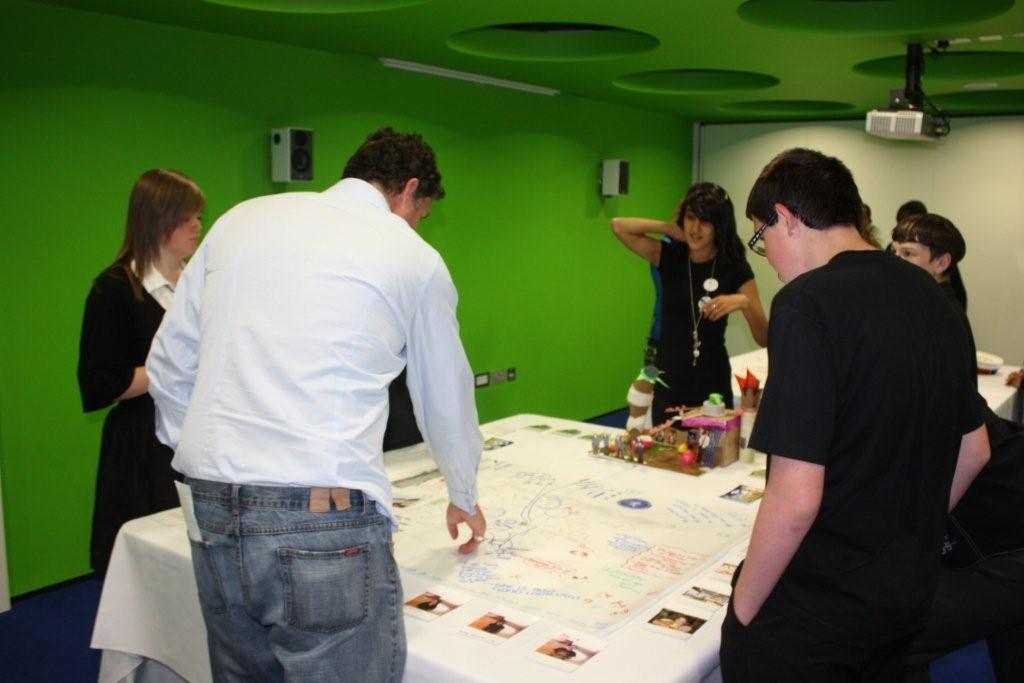AAO learned about another conference on obesity and planning through our sister association in the UK, the Architecture Centre Network. On June 30, planners and health professionals gathered in the West Midlands, UK for a conference entitled "Lessons to Take-Away: Planning, Health & Fast Food Lifestyles." This gathering, hosted by MADE (Midlands Architecture and the Designed Environment), encouraged collaborations across professions, discussed planning controls on the locations of fast food outlets, and even involved school children in mapping their food choices.
Jo Maguire, MADE's Marketing and Communications Manager, fills us in on the details.
 John Vincent, founder and director of Leon's (a healthy alternative to typical fast food restaurants), talks to the younger conference participants about their designs for fast food outlets and school canteens.
John Vincent, founder and director of Leon's (a healthy alternative to typical fast food restaurants), talks to the younger conference participants about their designs for fast food outlets and school canteens.
Lessons to Take-Away (June 2010) West Midlands UK
Jo Maguire, Marketing and Communications Manager, MADE
Lessons to Take-Away was a national conference for planning and health professionals held in the West Midlands on 30th June 2010. It was attended by 130 delegates and speakers from across England. These included: public health practitioners, trading standards and environmental health officers, nutritionists, and senior planning officers.
The aims of the conference included:
- encouraging planning and health professionals to work more closely together
- showcase pioneering planning controls on fast food take-aways
- show how engaging young people in their school’s food culture leads to popular and radical improvements.
Summary of points made by speakers:
- Prof Michael Waterson, University of Warwick
The major fast food chains started in London in the 1970s and grew steadily as people’s tastes were ‘developed’, with some regions apparently taking longer to ‘demand’ this new style of food than others. MacDonald's is respected by other chains for the care it takes in deciding its locations, with other chains often choosing neighbouring locations. - Prof Peter Dolton, Royal Holloway College University of London
Research to be published in summer 2010: an analysis of 1970 population cohort (at 16 years old in 1986) shows no causal link between BMI and close proximity to fast food. However, Prof Dolton added that the opportunity and exposure to high-calorie, high-fat food means today’s population is consuming more calories than previously. - Prof Jack Winkler, London Metropolitan University (pre-recorded film)
There is value in both reducing access to unhealthy fast food (such as through planning controls) and improving the nutritional content of what is currently on offer. Prof Winkler made the case for gradual and incremental improvements to nutritional content. - Dr Rosemary Kyle, Sandwell PCT
Food diaries revealed that primary age children in Sandwell consume 800-1000 calories on snacks between meals. - John Vincent, Founder and Director, Leon Restaurants
Explained that fast food can be healthy, nutritious, attractive and affordable. - Jenny Morris, Chartered Institute of Environmental Health, and Toni Smith, Food Standard Agency
Trading standards and environmental health officers are trained public health professionals, and that alongside their regulatory role, they can support businesses to be healthier and more profitable. - Shifa Mustafa, Acting Executive Director Environment and Regeneration, London Borough of Waltham Forest
Residents were overwhelmingly supportive of new supplementary planning guidance to control the number of fast food outlets near schools, youth centres and parks. Existing businesses supported the move to reduce excessive competition. The SPG was developed in recognition of an over-concentration of A3/A5 uses, domination of shop fronts, litter, disturbance, and poor image. The emphasis on ‘place-shaping’ supported this approach to control outlets.
Conference ethos:
- We chose a venue easily accessible by public transport and walking (The Public in West Bromwich), and we organised regular breaks during the conference for delegates to stretch their legs around the venue.
- We made sure that young people were involved as presenters, as these are the prime targets for the fast food industry.
- The delegate pack mimicked the brown paper bag of a take-away, complete with a quiz and toy (a health promotion item such as a stress ball or frisbee).
- Presentations were short and sharp, with practical information to implement.
- The venue caterers were able to provide a healthy lunch in ‘Airline’ style recycled cardboard boxes and recycled plastic pots. This was to emphasise the theme of the conference, and to remind delegates of the waste associated with take-away food.
For questions or for more information, contact Jo Maguire at Jo@Made.Org.Uk.
